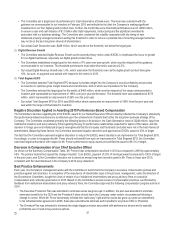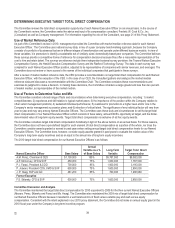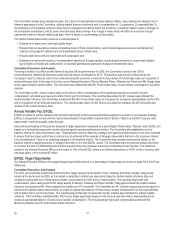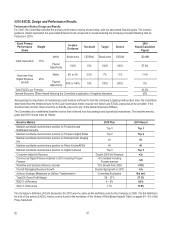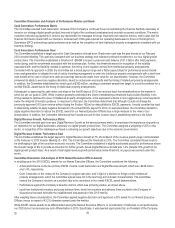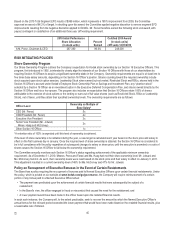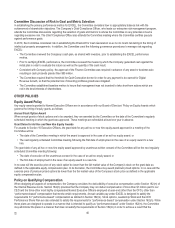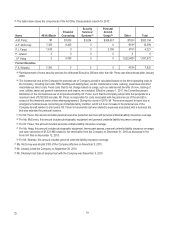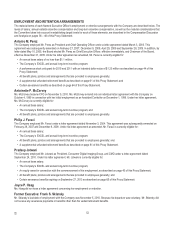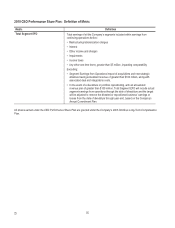Kodak 2010 Annual Report Download - page 172
Download and view the complete annual report
Please find page 172 of the 2010 Kodak annual report below. You can navigate through the pages in the report by either clicking on the pages listed below, or by using the keyword search tool below to find specific information within the annual report.
46
Committee Discussion of Risk in Goal and Metric Selection
In establishing the primary performance metrics for EXCEL, the Committee considers how to appropriately balance risk with the
achievement of shareholder objectives. The Company’s Chief Compliance Officer, who leads our enterprise risk management program,
attends the Committee discussions regarding the selection of goals and metrics to advise the Committee on any potential concerns
regarding excessive risk. The Chief Compliance Officer also attends the Committee meeting where the Committee certifies payouts
against performance goals.
In 2010, the Committee considered risk in establishing the threshold for Cash Generation so as not to incent risk-taking in the timing of
intellectual property arrangements. In addition, the Committee used the following governance procedures to manage risk regarding
EXCEL:
• The Committee reviewed the Company’s cash plan, as shared with investors, prior to establishing the EXCEL performance
metrics.
• Prior to certifying EXCEL performance, the Committee reviewed the means by which the Company generated cash against the
initial plan in order to evaluate the nature as well as the quantity of the cash result.
• Consistent with Company policy, the approval of the Finance Committee was required in advance of any asset or business sale
resulting in cash proceeds greater than $50 million.
• The Committee required that the threshold for Cash Generation be met in order for any payment to be earned for Digital
Revenue Growth, so that the potential risk of incenting profitless growth was mitigated.
• The Committee established baseline metrics to insure that management was not incented to take short-term actions which are
not in the best interests of shareholders.
OTHER POLICIES
Equity Award Policy
Any equity awards granted to Named Executive Officers are in accordance with our Board of Directors’ Policy on Equity Awards which
governs the timing of equity grants, as follows:
Annual Stock Option Award
When annual grants of stock options are to be awarded, they are awarded by the Committee on the date of the Committee’s regularly
scheduled meeting in which the grant was approved. These meetings are scheduled at least one year in advance.
Grant Dates for Ad Hoc and New Hire Equity Awards
For awards to Section 16 Executive Officers, the grant date for any ad hoc or new hire equity award approved in a meeting of the
Committee will be:
• The date of the Committee meeting in which the award is approved in the case of an ad hoc equity award; or
• The next regularly scheduled Committee meeting following the first date of employment in the case of an equity award to a new
hire.
The grant date of any ad hoc or new hire equity award approved by unanimous written consent of the Committee will be the next regularly
scheduled Committee meeting following:
• The date of execution of the unanimous consent in the case of an ad hoc equity award; or
• The first date of employment in the case of an equity award to a new hire.
In no case will the exercise price of any stock option be lower than the fair market value of the Company’s stock on the grant date as
defined in the applicable equity compensation plan. In its discretion, the Committee may award premium priced options. In no case will the
exercise price of premium priced options be lower than the fair market value of the Company’s stock price as defined in the applicable
equity compensation plan.
Policy on Qualifying Compensation
When designing all aspects of compensation, the Company considers the deductibility of executive compensation under Section 162(m) of
the Internal Revenue Code. Section 162(m) provides that the Company may not deduct compensation of more than $1 million paid to our
CEO and the three other most highly compensated Named Executive Officers employed at year-end (other than the CFO), other than
“performance-based” compensation that meets certain requirements. Annual variable pay under EXCEL is designed to satisfy the
requirements for “performance-based” compensation as defined in Section 162(m). Stock options, Leadership Stock and the CEO
Performance Share Plan are also intended to satisfy the requirements for “performance-based” compensation under Section 162(m). While
these plans are designed to operate in a manner that is intended to qualify as “performance-based” under Section 162(m), the Committee
may administer the plans in a manner that does not satisfy the requirements of Section 162(m) in order to achieve a result that the



